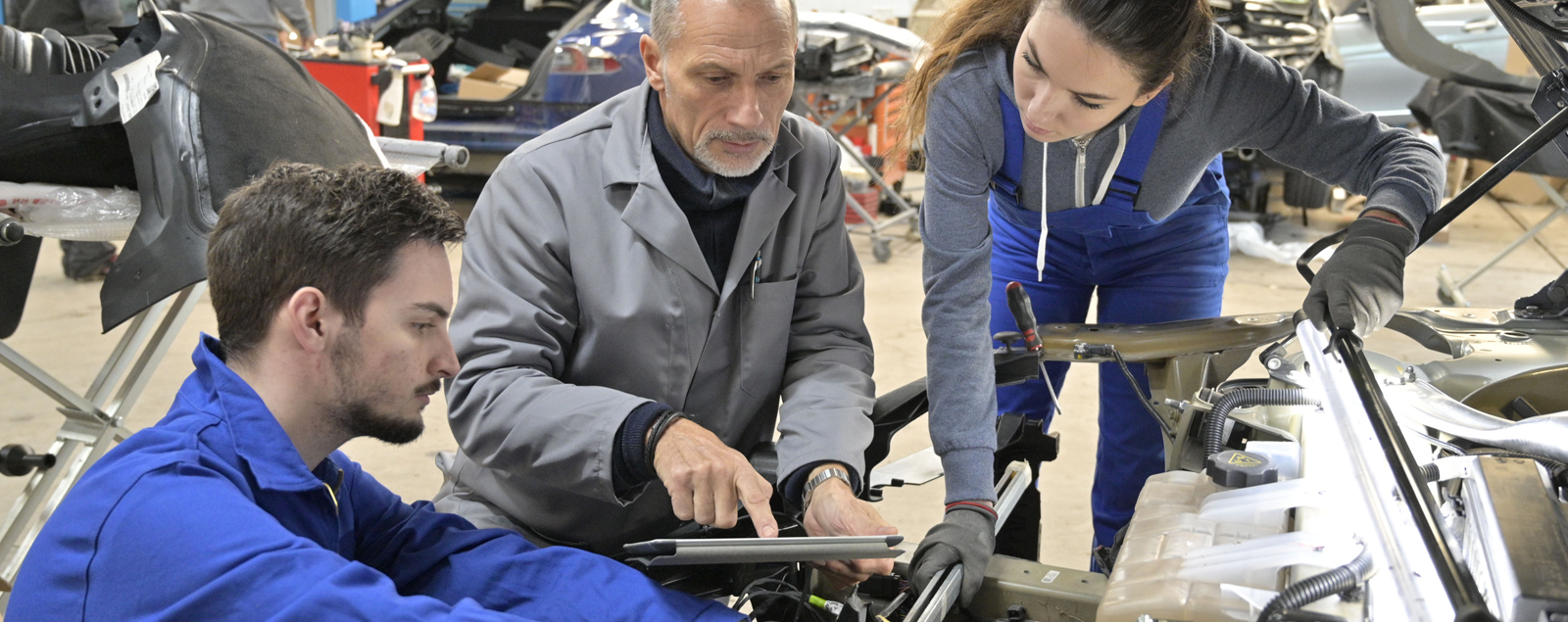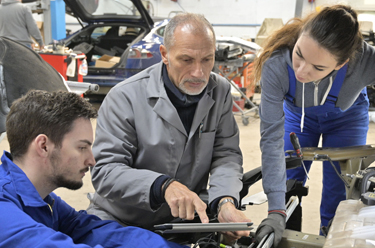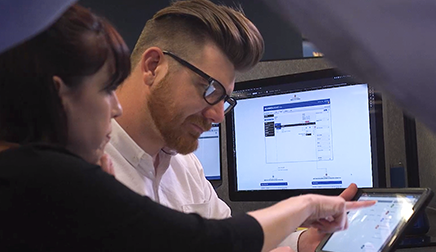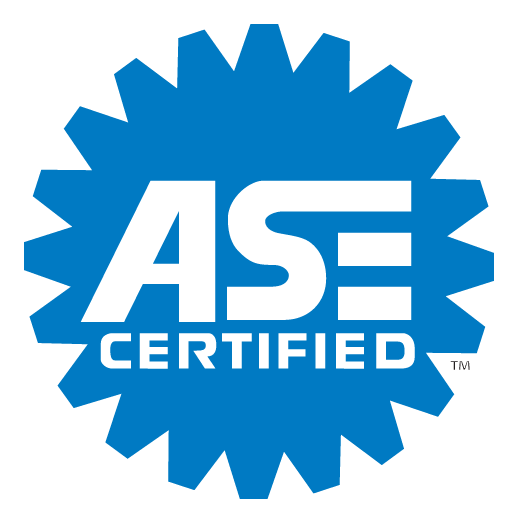
ASE testing and certification

Interview with ASE Vice President, David Milne
The National Institute for Automotive Service Excellence, better known as ASE, is an independent, non-profit, self-supporting organization that was created in 1972 to improve the quality of vehicle repair and service by testing and certifying automotive professionals. ASE has nearly 250,000 currently certified automotive technicians and service professionals working nationwide.
I had the pleasure to speak with David Milne, ASE vice president of credential testing programs. We discussed many of the questions that I’ve heard from technicians over the years about the ASE testing and certification program. Let’s dive right in…
RICH: To get the ball rolling, I’d like to clear up some misconceptions that technicians might have about the value of ASE certification. I hear a lot of techs saying, “I have a manufacturer’s certification. Why do I need an ASE certification too”?
My response is always, “Well, you can never have too many certifications. While the manufacturer’s certifications are excellent to have, you might not work for that brand forever. What happens if you want to go someplace else? ASE certification is recognized by every OE and independent shop across the nation.”
DAVID: You're absolutely right about that in terms of not limiting yourself to one manufacture’s certifications. Another aspect of our credentialling has to do with the fact that ASE’s professional credentialing is governed by case law. One of the first rules about this is, for a professional credential to be viable in the court system, the entity that’s doing the training can’t be the entity that’s doing the testing. That serves as a conflict of interest.
Above all else, we want our ASE credential to be defensible, particularly in court. Anytime you put together a professional credential and you use it for merit pay or hiring or firing, then somebody’s going to challenge that. In our almost 50 years, we have never been successfully sued over our ability to determine job competency. I think that’s the reason it’s so important that, even if you’re carrying a manufacturer’s certification, that you carry an ASE certification too. Many shops use ASE credentialing to determine base wages and pay increases.
RICH: This next question is always a hot topic when discussing ASE tests. Could you please tell us how the ASE test questions are developed?
DAVID: Sure. All ASE questions have their origin in a workshop facilitated by ASE and staffed by individuals from OE and independent shops who do the job every day for a living; not by academics who’ve never laid hands on a car before. We try to get a wide variety of those folks involved in each of the workshops. We’ll have 10 to 15 individuals in every workshop. And they not only come from independent shops and OEs they are also from geographically diverse areas because the job is not the same in every part of the country.
Above all else, we want our ASE credential to be defensible, particularly in court. Anytime you put together a professional credential and you use it for merit pay or hiring or firing, then somebody’s going to challenge that. In our almost 50 years, we have never been successfully sued over our ability to determine job competency.
The individuals in the workshops propose the questions to one another. Everybody must agree that the question is relevant and fair to ask of someone who is doing that job. They also must agree on the right answer, and that among the four choices provided, there is only one right answer. The other answers are what we call “plausible distractors.” They distract away the attention of somebody who’s less than knowledgeable on the topic.
One of the pitfalls some techs run into is drawing on experience of using a shortcut or an unapproved procedure. Maybe it was developed in their shop or some folks on social media are using it. They think that’s the right way to do it, but it may not be the industry-approved or manufacturer’s way of doing it.
RICH: In your opinion, are ASE questions based on hands-on experience? In other words, do you need to have hands-on experience to answer the questions correctly or could someone just study a book and pass the tests?
DAVID: That’s a great question. We look at questions in terms of four different levels of cognitive reasoning that you would need to have to answer a question correctly.
- The first level is just a knowledge question, which requires the individual to recall something they’ve memorized.
- The second level is a comprehensive level. That’s where the tech must understand the ideas, theories, and principles behind the concept to answer the question.
- The third level is what we call the application level. That’s where the tech needs to take ideas, theories, and principles and apply them to a practical problem to answer the question.
- The fourth level is what we call “analysis,” and that is where the candidate must take the information that’s given to them, break it down into its individual components, and determine how those things relate to one another so they can answer the question.
Now, somebody who’s just read a book can probably answer the knowledge questions, and sometimes even some of the comprehensive questions. But when we get to the application questions with practical problems, and particularly to the analysis questions where they must judge how certain things affect one another, then we find that those individuals who do not have hands-on experience are usually unable to answer those types of questions … and they make up most of the questions you’ll see on ASE tests.
RICH: A lot of techs, especially those who are taking their ASE certification tests for the first time, experience some anxiety. Do you have any tips on how to reduce the stress of taking ASE tests or any test for that matter?
Well, test anxiety is a real thing. When I talk to people about trying to combat that test anxiety, I first bring up to them that all the questions are written by their peers, people like themselves who do the job every day for a living. And we ask them to write about common problems. We don’t want questions about things that somebody’s going to see maybe once or twice in their career. We want common problems because we’re trying to determine if an individual can work independently, without somebody looking over their shoulder.
DAVID: Well, test anxiety is a real thing. When I talk to people about trying to combat that test anxiety, I first bring up to them that all the questions are written by their peers, people like themselves who do the job every day for a living. And we ask them to write about common problems. We don’t want questions about things that somebody’s going to see maybe once or twice in their career. We want common problems because we’re trying to determine if an individual can work independently, without somebody looking over their shoulder.
Also, we don’t want it to be a reading test. We want it to be a job-competency test. So, all our questions are written to about between a fifth and sixth grade reading level.
The question writers don’t want to write trick questions either. They feel like they’ve got a sense of commitment to all the other technicians out there. Plus, they’ve got to take the test too, so they want it to be fair and accurate.
And finally, what I tell them is, we have an editor who goes through and helps with sentence structure, reading level, punctuation, other grammar issues, so that we’re saying exactly what we intend to say. Changing the sentence structure just slightly can change the whole nature of the question.
RICH: Is there anything else you’d like to add to help relieve test anxiety?
DAVID: Yes, to earn an ASE credential, you can miss about 30 to 35 percent of the questions. And a lot of folks don’t understand that; they don’t know what the passing score is. So, they feel like it’s going to be at such a high level, they get discouraged. We don’t differentiate between the tech who gets all the questions right and the tech who passes by one point. They both get the same credential.
RICH: Thank you, that’s good to know. Say a tech is taking ASE tests for first time. What can they expect when they go to a Prometric test center?
DAVID: The Prometric test centers are utilized by a lot of folks other than ASE. There are doctors in there taking their AMA boards or CPAs taking their CPA exams or electricians in there taking their certification tests. So, we must abide by the most stringent criteria that any one of those testing agencies might impose.
When you go there, you’re going to be asked to turn out your pockets and put everything into a locker. They may even wand you to determine if you’ve got anything else on you. If you’ve got glasses, they’re going to ask to inspect those glasses. Auto technicians are not exactly used to that kind of security, so I tell them to be prepared for it but know that they’re not being treated differently than anyone else who goes into one of those test centers.
RICH: That’s an excellent point. What about when it comes to taking the tests, how are they administered?
DAVID: Well, the testing is done on a computer. You just move a curser around and click on the answers. I think it’s rare these days to find someone who hasn’t had exposure to the basic computer skills required to take these tests.
RICH: It’s so much better now than the old days when we had used a pencil to fill in tiny boxes on a score sheet. If you got just one question off on the score sheet, and didn’t notice until towards the end, you’d have to erase all your answers and start over again. It’s so much faster to take the tests online and they are a lot easier to read. Plus, you can mark a question you’re not sure about and come back to it later. Sometimes another question will help you answer the one you struggled with.
DAVID: In the past when we were scoring those test sheets, it was easy to see who made that mistake too because they did fine up to one point in the test and then it all went south.
RICH: What would you say to entry-level techs in the automotive and collision-repair field about the importance of taking ASEs? In your opinion, why would it be important for them to take ASE tests and keep them current?
DAVID: I think the most important thing is to differentiate yourself from all the others out there in this industry. The auto industry used to rank as number one in consumer complaints. We’re no longer number one but we’re still in the top 10. I think it’s important to provide employers and customers with tools that help differentiate good techs from those who are less than knowledgeable. I think that’s probably the most important reason.
Also, ASE certifications are portable. They can follow you wherever you go in the industry. And certifications are still one of the most requested credentials for any occupation when hiring an individual. They are the most recognized yardstick we have in our industry for telling the public and a shop owner what your job competency is.
RICH: That’s an excellent point Dave. We don’t really have – especially the west coast – apprentice programs anymore or apprentice schools like they have on the east coast. ASE certifications are also a great way for an employer to track a technician’s knowledge and skill level as they advance through their careers.
DAVID: Yes, they are.
RICH: Many shops I worked for in the past would pay the techs 50 cents an hour more for every ASE we could get and 25 cents more for every recertification, so there was a big financial incentive to get and maintain ASE certifications.
Technicians are becoming more highly valued now, especially since we’re getting ready to lose about 50 percent of our workforce to retirement. They’re starting to see the need to provide a well-defined career ladder for their employees to entice them to stay put.
DAVID: Very true. Many employers are still using that along with other types of incentives. Technicians are becoming more highly valued now, especially since we’re getting ready to lose about 50 percent of our workforce to retirement. They’re starting to see the need to provide a well-defined career ladder for their employees to entice them to stay put. ASE tests can be used as a reliable and fair way show how someone is progressing in their career ladder. And we know that people with ASE credentials have about a 300 percent higher tenure than those without.
RICH: That’s a very interesting statistic.
DAVID: Yes, it is but a lot of employers don’t want to make that investment. They say, “I don’t want to train them so they can pass the ASE tests because they may leave.” That’s not the case. Techs will usually stay with a shop because they appreciate the owner investing in their career.
RICH: I wholeheartedly agree. In a shop-management article I wrote a while back, my advice to shop owners who didn’t want to invest in training because the techs may leave anyway was, “What happens if you don’t?” You are more likely to lose your valuable techs to a shop who is willing to invest in them. Skilled, knowledgeable technicians are the life blood of your business because their work is the product you’re selling. As a shop owner, you need to build strong loyalty with your employees. Training helps do just that.
RICH: When I was an instructor at UTI, some of the students were getting ASE entry-level certifications. Could you please explain what those are?
DAVID: Yes, of course. Those certifications are part of the cradle-to-grave concept that we at ASE support. We want to address the needs of technicians from the moment they are ready to join the workforce until they finish their career. It originally began with our ASE Education Foundation accredited schools. We have about 2,300 of them around the U.S. The equivalency certifications tests were initially end-of-course tests at the foundation schools. But in many states, in order to back a vocational school, they want their students to come out with an actual credential.
So, we took these 12 or 14 end-of-course tests and turned them into an entry-level credential that students could earn. They’ve been very well received and we’re issuing a lot of credentials to students. I’d like to note that the credential is only good for two years and cannot be renewed. Techs need to move on to the regular ASE tests.
We also have a stepping-stone test that is our G1, Maintenance and Light Repair test. Techs who have been in the industry for a year have adequate experience to earn that credential before stepping up to the full ASE tests.
RICH: And speaking of tests, could you please tell us the best way to prep for ASE certification tests?
DAVID: Certainly. We like to say that doing the job every day for a living – well, doing the job according to industry or manufacturers’ accepted practices every day – is the best preparation for our tests.
Additionally, something that many people don’t realize is, although it would be a conflict of interest for us to do the training and the testing, it is incumbent upon us to tell candidates what they’ll be tested on. Our study guides can be downloaded from our website, or you can contact customer service and ask them to send you a hardcopy.
The study guides include the “test specifications and task lists” for each of the tests. We show you the general content areas that you’ll be tested on and the number of questions that you’ll see in each of those areas. Then, we break each of those general content areas down into the hands-on tasks, which you should be familiar when you come to take the test.
Now, you’re not going to get all the questions. That’s the beauty of a competency-style test; you must be prepared for everything. If you’re honest with yourself as you go through a task list, and you’re confident you know how to perform each one, you should be prepared.
RICH: Is there anything else you can tell us about the questions in the ASE study guides?
DAVID: The study guide questions are ones that we’ve pulled out of the tests and put in the study guide. But they’re not really designed to train you. They’re designed so candidates can get familiar with of the types of sentence structure and formats we use for the questions.
Now, we also have our practice tests online, which have a cost to them. I think they run between $14 and $17 each. Those are half the length of the regular ASE tests, and the questions are built with the same difficulty as the ones that you would see on the certification test. So, if you were to pass a practice test, that would be a pretty good indicator of how you will do on the actual ASE test.
RICH: I’ve used those online practice tests myself just as a gut check to see how well I was prepared. If I did well, then I felt fairly confident I’d pass the actual certification test. If I didn’t do well, I had a roadmap of topics I needed to study.
I think techs could go through their self-assessment using the ASE study guides and task lists, then look those topics up on ALLDATA to find out exactly what the industry procedures are for completing that task correctly.
RICH: How can someone use ALLDATA in the test-prep process? Maybe to help prepare for the task-driven portion of the test preparation perhaps?
DAVID: Yeah. I think techs could go through their self-assessment using the ASE study guides and task lists, then look those topics up on ALLDATA to find out exactly what the industry procedures are for completing that task correctly.
RICH: A lot of techs have asked this question about the L1, Advanced Engine Performance Specialist test composite vehicle. Is that vehicle based on any one demographic group of manufacturers (such as Domestic, Asian, European)?
DAVID: The composite vehicle really is an amalgamation of a lot of different vehicles, not any one manufacturer or group. It’s a totally fictitious vehicle. Basically, what all the test writers agreed on was that, if you tell someone the systems the vehicle has, provide a list the components, tell them what the specifications are for each of those components, and you tell them how the components communicate, then someone should be able to work it out. Basically, the composite-vehicle booklet becomes your service information resource to use to help answer the questions.
RICH: Thanks for clearing that up. Well, that’s all the questions I had. Is there anything else you would like to add?
DAVID: Yes, there’s another function I perform for ASE that I’d like to take a minute to talk about. Besides my duties as vice president of credential testing programs, I am also the president of the ASE Training Managers Council. And, as I mentioned earlier in this interview, it’s a conflict of interest for ASE to conduct training and conduct the testing. But we realize how vital training is to the success of this industry.
So, we wanted to do everything we could to support trainers in their role, and we do that through the ASE Training Managers Council. We allow trainers from both the OEs and the independents to come together and use their collective knowledge to look at how people will train in the future, and then help each other prepare for that future. It’s a very interesting networking organization and I think the automotive industry will greatly benefit from the council’s efforts.
RICH: Thank you so much Dave for taking time from your busy schedule to speak with us. And thanks for all the hard work you and the great folks at ASE put in to improve our industry.
Look at our entire suite of products to determine your shop’s needs.
If you would like to read more articles like this one please subscribe to ALLDATA News.
About the author
Rich Diegle, has 35 years of experience as a master automotive technician, marketing and public relations manager, senior automotive editor, and instructor.








